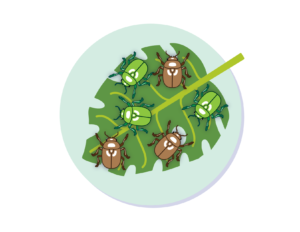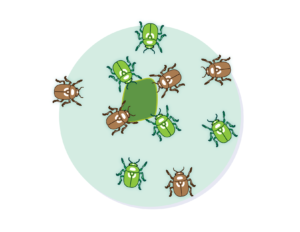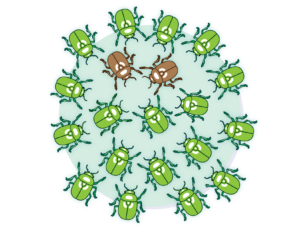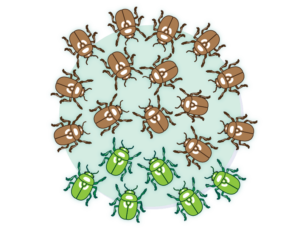We’ve defined evolution as descent with modification from a common ancestor, but exactly what has been modified? Evolution occurs when there is a change in the heritable information passed from one generation to the next. Typically, we think of biological evolution as changes in gene frequency within a population over time – if, say, birds with genes that produce wide beaks went from being rare to being common over multiple generations. But biological evolution also includes changes in DNA that does not code for genes and changes in heritable information not encoded in DNA at all. In all of these cases, the modifications are heritable and can be passed on to the next generation — which is what really matters in evolution: long term change. Here, we’ll focus on changes in genes and other genetic elements (e.g., in non-coding DNA) as they relate to evolution.
Compare these two examples of change in beetle populations. Which one is an example of evolution?
 1. Beetles on a diet
1. Beetles on a diet
Imagine the population experiences many years of drought in which there are few plants that the beetles can eat.
 All the beetles have the same chances of survival and reproduction, but because of food restrictions, the beetles in later generations are smaller than the pre-drought generations of beetles.
All the beetles have the same chances of survival and reproduction, but because of food restrictions, the beetles in later generations are smaller than the pre-drought generations of beetles.
 2. Beetles of a different color
2. Beetles of a different color
Most of the beetles in the population (say 90%) have a gene for green coloration and a few of them (10%) have a gene that makes them brown.
 Several generations later, things have changed: brown beetles are more common and make up 70% of the population.
Several generations later, things have changed: brown beetles are more common and make up 70% of the population.
Which example illustrates descent with modification? The difference in size in example 1 came about because of environmental influences — the low food supply — not because of a change in heritable information. Therefore, example 1 is not evolution. Because the small body size in this population was not genetically determined, it is temporary: if the beetles’ food supply is restored, this generation of small-bodied beetles will produce normal size offspring.
The shift in color frequency in example 2 is definitely evolution: these two generations of the same population are genetically different. There has been a change in heritable information, and this shift will be passed down to the next generation (possibly with further changes introduced). But how did it happen?
See how genes can affect observable characteristics in genotype versus phenotype.
Learn more about distinguishing evolutionary change from other sorts of change in this news brief about climate change or this research profile about altitude adaptation.
Teach your students about gene frequency and changes in gene frequency:
- Breeding bunnies, a classroom activity for grades 9-12.
Find additional lessons, activities, videos, and articles that focus on gene frequency.
Reviewed and updated June, 2020.
